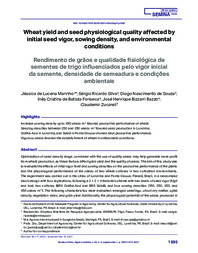Wheat yield and seed physiological quality affected by initial seed vigor, sowing density, and environmental conditions
Wheat yield and seed physiological quality affected by initial seed vigor, sowing density, and environmental conditions
Autoria: MARINHO, J. de L.; SILVA, S. R.; SOUZA, D. N. DE; FONSECA, I. C. DE B.; BAZZO, J. H. B.; ZUCARELI, C.
Resumo: Optimization of seed density range, combined with the use of quality seeds may help generate more profit from wheat production, as these factors affect grain yield and the quality of seeds. The aim of this study was to evaluate the effects of initial vigor level and sowing densities on the productive performance of the plants and the physiological performance of the seeds of two wheat cultivars in two cultivation environments. The experiment was carried out in the cities of Londrina and Ponta Grossa, Paraná, Brazil, in a randomized block design with four replications, following a 2 × 2 × 4 factorial scheme with two levels of seed vigor (high and low), two cultivars (BRS Gralha-Azul and BRS Sabiá), and four sowing densities (150, 250, 350, and 450 seeds m-2). The following characteristics were evaluated: emerged seedlings, shoot dry matter, spike density, vegetation index, and grain yield. Additionally, the physiological potential of the seeds produced in Londrina was evaluated by first germination count, germination, accelerated aging, seedling emergence, and emergence speed index tests. The increase in density up to 450 seeds m-2 favored the productive performance of the crop in both cultivation environments; however, it reduced the physiological performance of the seeds produced in Londrina. The cultivars BRS Gralha-Azul and BRS Sabiá had better performance and grain yield in Londrina and Ponta Grossa, respectively. High-vigor seeds favored the establishment of the stand, especially under unfavorable environmental conditions. Key words: Germination. Plant population. Seed quality. Triticum aestivum L.
Ano de publicação: 2021
Tipo de publicação: Artigo de periódico
Unidade: Embrapa Trigo
Palavras-chave: Aspecto Fisiológico, Densidade de Semeadura, Fisiologia, Grão, Semeadura, Semente, Trigo
Observações
1 - Por padrão são exibidas publicações dos últimos 20 anos. Para encontrar publicações mais antigas, configure o filtro ano de publicação, colocando o ano a partir do qual você deseja encontrar publicações. O filtro está na coluna da esquerda na busca acima.
2 - Para ler algumas publicações da Embrapa (apenas as que estão em formato ePub), é necessário ter, no celular ou computador, um desses softwares gratuitos. Sistemas Android: Google Play Livros; IOS: iBooks; Windows e Linux: software Calibre.
Acesse outras publicações
Acesse a Base de Dados da Pesquisa Agropecuária (BDPA) para consultar o acervo completo das bibliotecas da Embrapa.

